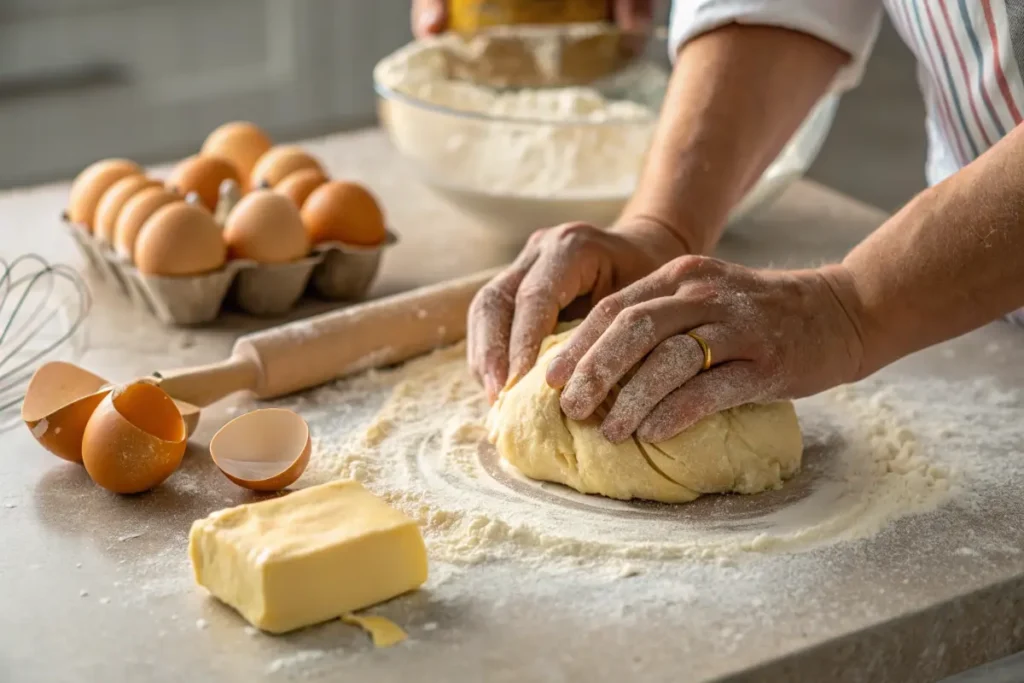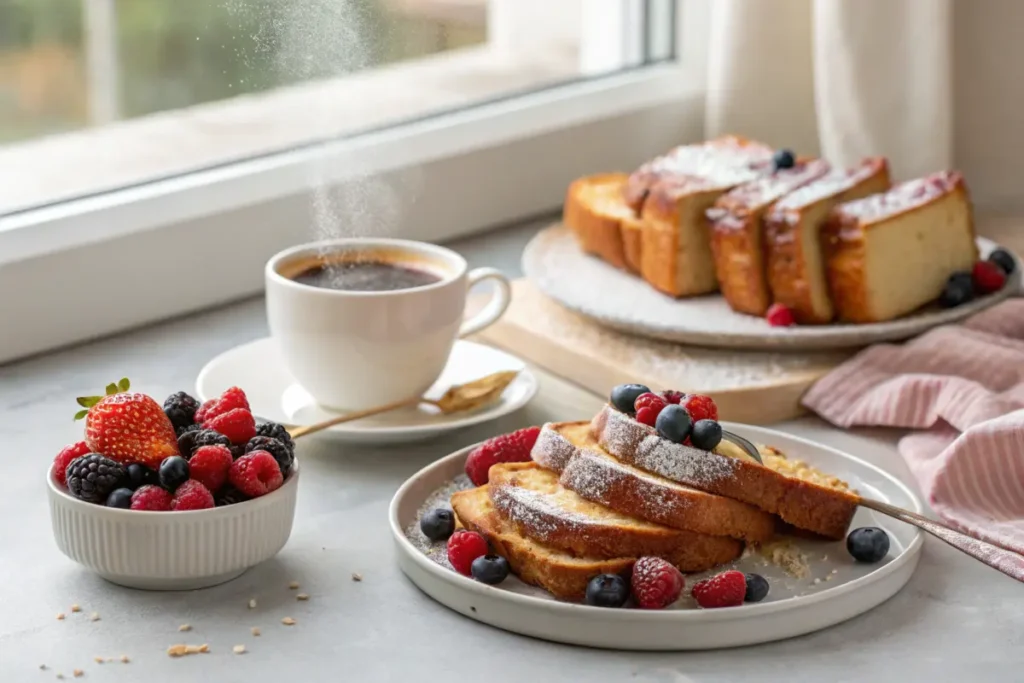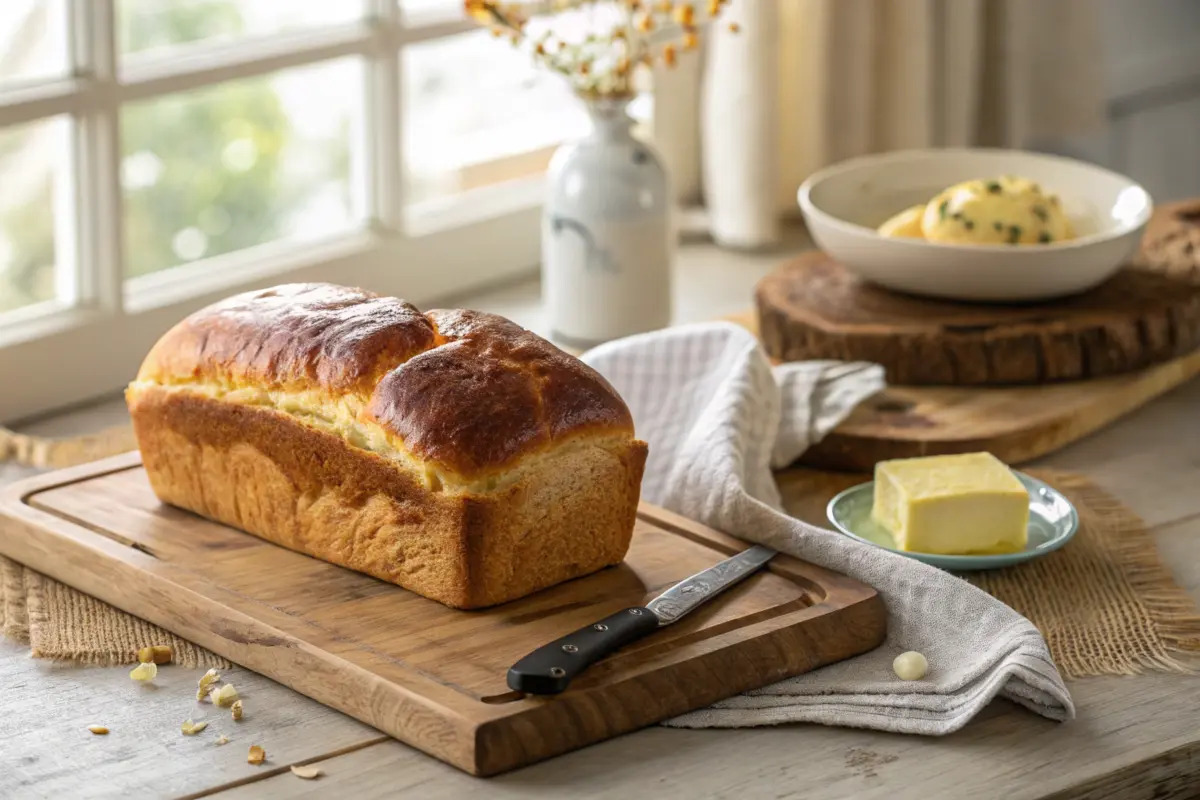Brioche is a delightful bread that stands apart from most other loaves in both texture and flavor. But what makes it so special? This article dives into the history, unique ingredients, and techniques behind this buttery French bread. You’ll discover what sets brioche apart and how it became a favorite for both sweet and savory recipes. Whether you’re a seasoned baker or a curious foodie, there’s something fascinating in every slice of this story.
Introduction to Brioche
What Is Brioche?
Brioche is a type of French bread that blends the qualities of bread and pastry. It’s known for its buttery richness, tender crumb, and slightly sweet flavor. Unlike your typical sandwich loaf, brioche is enriched with eggs and butter, giving it a distinctive golden hue and a melt-in-your-mouth texture.
Brioche is more than just bread; it’s a symbol of indulgence. It’s the kind of treat that elevates a simple breakfast or dessert into something extraordinary. While it’s traditionally served in French cuisine, its versatility has made it a global favorite.
Why Is Brioche Special?
So, what makes a brioche different to most breads? The secret lies in its ingredients and preparation. Unlike standard bread, which relies on flour, water, yeast, and salt, brioche adds butter, eggs, and sugar to the mix. These elements create a luxurious texture and flavor profile that’s unmatched by other types of bread.
Brioche is also unique in its preparation. The dough requires careful mixing to develop elasticity and patience during fermentation to bring out its rich, buttery taste. It’s a labor of love that results in a bread that’s as versatile as it is delicious, perfect for everything from French toast to gourmet burgers.
Origins and History of Brioche
French Roots and Culinary Heritage
Brioche has deep roots in French culinary traditions, dating back to the 17th century. This butter-rich bread was initially crafted to reflect the luxurious ingredients available to the aristocracy. While common bread aimed to be a staple, brioche was designed to indulge the senses, pairing perfectly with French elegance.
Legend has it that Marie Antoinette brought brioche into the spotlight during her reign. Although the infamous phrase “Let them eat cake” might have been misattributed, brioche became synonymous with French sophistication. Over centuries, it evolved from a delicacy for the elite to a beloved staple in households worldwide.
Evolution Over Time
The brioche we enjoy today has adapted to various cultures, finding its place in sweet and savory recipes alike. In France, it’s often enjoyed plain or lightly toasted with a touch of jam, while globally, it’s transformed into gourmet hamburger buns or even French toast. The versatility of brioche reflects its universal appeal, making it one of the most cherished breads across the globe.
For an in-depth step-by-step guide on mastering brioche recipes, check out this resource.
Key Ingredients That Set Brioche Apart
The Role of Butter
What truly sets brioche apart is its high butter content. Unlike most breads, which rely on minimal fats, brioche incorporates generous amounts of softened butter into the dough. This not only gives it its signature rich flavor but also contributes to the tender, almost cake-like texture that makes every bite feel indulgent.
Eggs and Their Functionality
Eggs play an equally important role in making brioche unique. Acting as a natural emulsifier, eggs create a smooth dough that’s easy to work with and contributes to the bread’s golden color and silky texture. The yolks, in particular, add a richness that elevates the bread’s flavor beyond the ordinary.
The Sweet Element
The addition of sugar further distinguishes brioche from typical breads. Although it’s not as sweet as cake, the subtle hint of sugar adds complexity to its flavor profile. This sweetness enhances its ability to pair with both savory fillings like smoked salmon and sweet toppings like honey or Nutella.
These ingredients, combined with careful preparation techniques, explain what makes a brioche different to most breads and why it continues to be a favorite for bakers and food enthusiasts alike.
The Science Behind Brioche’s Texture and Flavor

High-Fat Content and Its Impact
One of the most significant scientific factors that makes brioche different from most breads is its high-fat content. Unlike lean bread doughs made with just flour, water, yeast, and salt, brioche incorporates butter and eggs, which fundamentally alter the structure of the dough. This fat interferes with gluten development, making the bread soft and tender instead of chewy.
The butter also enriches the dough, creating a velvety texture. When baked, this enriched dough forms a delicate crumb structure that almost melts in your mouth. No wonder brioche is a favorite for gourmet dishes!
Dough Mixing Techniques
Achieving the perfect brioche texture requires more than just mixing ingredients. Bakers must knead the dough long enough to develop gluten strands, which provide the necessary elasticity to trap air. This step is crucial for brioche’s characteristic fluffiness.
The dough’s fat content, however, makes this process challenging. The butter must be added gradually, allowing it to integrate fully without breaking the dough. This careful technique ensures that the dough remains pliable and airy, resulting in a perfect brioche.
Fermentation and Flavor Development
Another essential step in brioche baking is cold fermentation. Allowing the dough to rise in the fridge slows yeast activity, giving the flavors time to develop. This slow rise is why brioche has a rich, buttery taste that stands out among other breads. The longer fermentation also helps the dough retain its shape during baking, ensuring a fluffy interior.
For other bread recipes that utilize slow fermentation techniques, consider exploring this detailed guide.
Baking Techniques for Perfect Brioche
Shaping and Proofing the Dough
Shaping brioche dough can feel like an art form. Because it’s softer than typical bread doughs, it requires a gentle touch. To create the classic brioche shape, bakers divide the dough into small balls and arrange them in a mold. This technique not only gives the bread its iconic look but also helps it bake evenly.
Proofing, or the final rise, is another critical step. The dough must double in size before baking, allowing it to achieve its signature light and airy texture. Skipping or rushing this step can lead to a dense, disappointing loaf.
Achieving the Right Texture
The oven temperature and baking time play a huge role in brioche’s success. Brioche is usually baked at a moderate temperature to ensure it cooks through without burning. The butter-rich dough creates a stunning golden crust, which is often brushed with egg wash for added shine and flavor.
When baked to perfection, the result is a bread with a soft, fluffy interior and a slightly crisp, buttery crust—a combination that’s simply irresistible.
Common Pitfalls to Avoid
Making brioche can be tricky, especially for beginners. Common mistakes include using cold butter, which prevents proper mixing, or under-proofing the dough, which results in a dense texture. Another common error is over-baking, which dries out the bread. By paying close attention to these details, you can master brioche baking at home.
Versatility of Brioche in Culinary Applications
Sweet Applications

Brioche is a natural choice for sweet dishes because of its slightly sugary flavor and buttery richness. One of its most famous uses is in French toast. The bread’s tender crumb soaks up custard beautifully, creating a dish that’s crisp on the outside and creamy on the inside. Similarly, brioche shines in bread pudding, where its soft texture blends seamlessly with the creamy mixture.
Beyond these classics, brioche is also popular in desserts like donuts or even enriched pastry creations. Its subtle sweetness pairs well with flavors like cinnamon, chocolate, and fruit, making it an excellent base for indulgent treats.
Savory Creations
On the savory side, brioche’s light yet rich texture makes it perfect for gourmet sandwiches and burgers. It’s no surprise that upscale restaurants often use brioche buns—they’re soft enough to complement fillings yet sturdy enough to hold together.
Brioche also serves as a base for savory pies or tartlets, thanks to its ability to balance richness without overpowering. Whether topped with smoked salmon, roasted vegetables, or cheeses, brioche elevates savory dishes to a whole new level.
Why Brioche Is a Chef’s Favorite
Brioche’s versatility stems from its ability to adapt to a wide range of flavors and textures. It can hold its own in intricate recipes or shine simply toasted with butter. This adaptability, along with its distinctive ingredients, underscores what makes a brioche different to most breads. No matter the occasion, brioche is a star ingredient in any kitchen.
Comparing Brioche to Other Breads
Higher Fat Content
One of the biggest distinctions between brioche and most other breads is its higher fat content. Traditional bread recipes focus on lean ingredients, whereas brioche incorporates a generous amount of butter and eggs. This addition not only gives brioche its golden color and soft texture but also sets it apart from drier, more rustic breads like baguettes or sourdough.
Texture and Taste Comparison
While most breads lean toward a chewy or crusty texture, brioche boasts a tender crumb that almost dissolves in your mouth. Its flavor, too, is unique. Where rustic breads are earthy and simple, brioche is subtly sweet and decadently rich.
The bread’s luxurious quality makes it stand out even when compared to enriched breads like challah or milk bread. Both may share some similarities with brioche, but they lack the same balance of sweetness and buttery flavor that defines brioche.
Brioche as a Hybrid Bread
Brioche is often described as a hybrid between bread and pastry. Its dough rises with yeast like bread but contains enough fat to give it a cake-like quality. This duality is another key factor in what makes a brioche different to most breads. It’s a versatile base that combines the best of both worlds.
FAQs About Brioche
How Is Brioche Different from Regular Bread?
This is one of the most common questions: What makes a brioche different to most breads? The answer lies in its ingredients. Unlike standard bread that uses a basic mix of flour, water, yeast, and salt, brioche is enriched with butter, eggs, and sugar. These additions make brioche richer, softer, and slightly sweeter than regular bread.
Can Brioche Be Used in Savory Dishes?
Absolutely! While brioche’s subtle sweetness makes it ideal for desserts, it’s just as versatile in savory dishes. Many chefs prefer brioche buns for burgers because they’re soft but sturdy. It’s also a fantastic base for savory bread puddings, tartlets, or simply as a side for soups and stews.
What Makes Brioche So Soft and Fluffy?
The secret to brioche’s light texture is its high-fat content and careful preparation. Butter and eggs enrich the dough, while slow mixing and proofing ensure it rises evenly. The result is a bread that’s airy yet indulgent, perfect for both simple and sophisticated recipes.
How Do You Store Brioche to Maintain Freshness?
To keep brioche fresh, store it in an airtight container at room temperature for up to three days. For longer storage, freeze it. When ready to enjoy, reheat gently in the oven to restore its soft texture. Proper storage ensures you can savor its unique qualities any time.
Tips for Making Homemade Brioche
Choosing the Right Ingredients
When making brioche at home, start with high-quality ingredients. Use fresh eggs and unsalted butter for the best flavor. Good-quality flour also matters—opt for bread flour, which has higher protein content to help with structure and elasticity.
Step-by-Step Process
Making brioche requires patience, but the results are worth it. Begin by mixing your ingredients and kneading the dough until it’s smooth and elastic. Gradually incorporate softened butter to create a silky texture. Let the dough proof in the fridge overnight to develop its flavor. After shaping, proof again before baking to ensure a light, fluffy crumb.
Troubleshooting Common Issues
Brioche can be challenging, but a few tips can help. If your dough is too sticky, don’t add more flour; instead, chill it for easier handling. For uneven baking, ensure your oven temperature is accurate. These small adjustments can make the difference between good brioche and perfect brioche.
Curious to try a recipe? Check out this step-by-step guide to mastering brioche.
Conclusion and Final Thoughts
Summary of Brioche’s Unique Qualities
Brioche isn’t just bread—it’s a culinary masterpiece that bridges the gap between pastry and traditional loaves. Its rich combination of butter, eggs, and sugar creates a flavor and texture that stand out in the world of baking. Whether you’re making French toast, burgers, or a simple slice with jam, brioche always adds a touch of indulgence. This unique versatility highlights what makes a brioche different to most breads and why it remains a favorite for chefs and home bakers alike.
Encouragement to Try Brioche
While brioche may seem daunting to make at home, it’s a rewarding experience for any baker. With a little patience and the right techniques, you can create a loaf that rivals those found in French patisseries. Whether you buy it or bake it, brioche is worth every bite—its buttery richness and airy crumb make it a treat that’s hard to resist.
So, why not explore the world of brioche? Try incorporating it into your next breakfast or dinner, and you’ll see firsthand why this bread is beloved worldwide. Happy baking!

